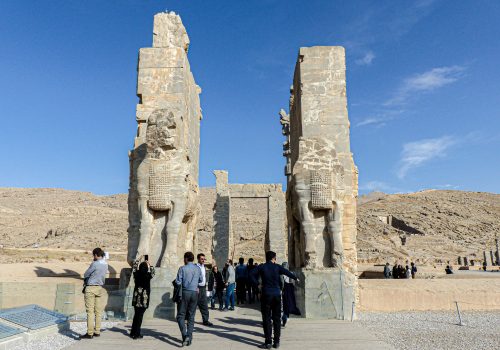Iran’s economy and the burden of multiple exchange rates
The Iranian economy has been struggling since the establishment of the Islamic Republic in 1979 for a number of reasons, including the government’s hardline foreign policies that challenge major world powers and their tensions with other countries in the Middle East.
A devastating eight-year war with Iraq still consumes a portion of the country’s financial resources. Furthermore, the country is beset with domestic, political, and social turbulence, as well as mismanaged and flawed economic policies implemented by inexperienced politicians and government officials. On top of all of this, US re-imposed sanctions have crippled Iran’s access to the international financial system and market. Consequently, the Iranian rial has precipitously been devaluating and has fallen from seventy rials to the dollar in 1979 to 165,000 rials, today. The government has sought to disguise and compensate for this drop by creating multiple exchange rates and, in its latest gambit, a plan to phase out the rial altogether, knock off four zeros, and issue a replacement currency—the toman. The latter will most likely not make any difference for Iran’s economy unless supported by economic reforms and removed sanctions.
Contrary to a common misperception outside Iran, the private sector is the largest employer in the country. Private companies are directly or indirectly dependent on international trade by being engaged in the export supply chain or being consumers of imported goods or both. The importance of the private sector in creating jobs and helping ordinary Iranians survive—in addition to providing communities with required products and services—should not be underestimated.
Since the early days of the Islamic Republic, business and financial players faced the challenge of dealing with, at least, two significantly different rial exchange rates when conducting international activities: the official rate that is defined and subsidized by the Central Bank of Iran (CBI) and a floating one controlled by unregulated market supply and demand. The imbalance between the two rates quickly brought inefficiencies to Iran’s international trade activities that have persisted for decades. Introduction of a third exchange rate in April 2018, a so-called Forex Management Integrated System (NIMA), has not made Iran’s international trade and access to hard currency much better. Rather, it has created new survival challenges for Iranian businesses. The NIMA rate was introduced by the CBI as the Iranian government anticipated the Trump administration’s unilateral withdrawal from the Joint Comprehensive Plan of Action (JCPOA), which it did on May 2018, followed by the re-imposition of sanctions, which have hit the Iranian economy, businesses, and people harder than ever.
Currently, Iranian businesses have to navigate the official rate, the NIMA rate controlled by the CBI, and the floating market rate. The same “money-moving network” serves the currency exchanges between the Iranian rial and hard currencies. Additionally, it performs international transactions for Iranian importers and exporters and their foreign suppliers and customers independent of the assigned exchange rate. This sophisticated network consists of a great number of exchange offices, bank accounts, and companies in Iran and around the globe. Imagine a Western Union set-up, but on a much greater and advanced scale.
Iranian companies that import “vital” products—e.g. medicines, meat, wheat—are entitled to use the subsidized official exchange rate (42,000 IRR = 1 USD). The importers of “essential” products—e.g. electronics, production machineries, agricultural seeds, tea—which are not possible to manufacture in Iran or not produced at high enough levels to meet market demand, are entitled to use the NIMA exchange rate (154,000 IRR = 1 USD). Other importers use the floating market rate (162,000 IRR = 1 USD). Exporters, on the other hand, are forced to declare and to sell a significant portion of their hard currency, obtained through overseas earnings, to CBI’s NIMA system. This varies from fifty percent to up to ninety percent of their hard currency, depending on the size of their earnings (exporters that earn less than one million euros per annum are exempt from selling their hard currency to the NIMA system).
The Iranian government tries to circulate as much hard currency as possible between importers and exporters through the NIMA system, while providing importers with an exchange rate that is lower than the floating rate. This is because the government lacks the financial strength to support Iran’s entire international trade with its fully subsidized official exchange rate. The NIMA set-up may be considered as a “solidarity financial system” among importers and exporters, but it, in fact, operates at the expense of exporters. As the NIMA rate rapidly gets closer to the floating rate, it may soon collapse. In the end, the entire burden is put on the private sector’s shoulders.
The biggest challenge for the majority of Iranian exporters is that, while they are forced to integrate into the NIMA system and are, therefore, forced to sell most of their hard currency, they are not necessarily entitled to obtain official or NIMA exchange rates when importing raw material or other products for their operations. Instead, they have to use the floating rate. This exchange rate imbalance makes domestic operations more expensive and gradually forces exporters to consume more of their Iranian rials than add to them, which will eventually result in financial deficits. A domino effect in the connected business ecosystem will, then, cause increased product prices down the supply/demand chain, resulting in increased operational costs for all parties, which will ultimately cause companies to go bankrupt and increase unemployment and poverty.
As the imposed sanctions limit international business activities and further weakens the national currency, the consequences for the private sector and, thus, ordinary Iranians are devastating and unjust. Whatever sanctions on Iran were intended to accomplish, they will always directly make ordinary people pay the heaviest price.
Mohsen Tavakol is an international business executive, technology entrepreneur, investor and advisor on sanctions, international trade compliance, and business ethics. He is also a nonresident senior fellow at Atlantic Council. Follow him on Twitter: @Mohsen_Tavakol.
Image: A worker assembles a vehicle at a production line of carmaker Iran Khodro, west of Tehran June 20, 2011. REUTERS/Morteza Nikoubazl


